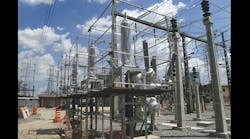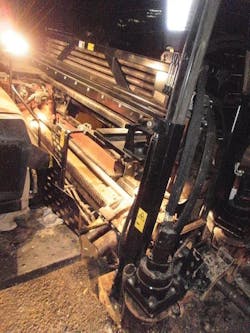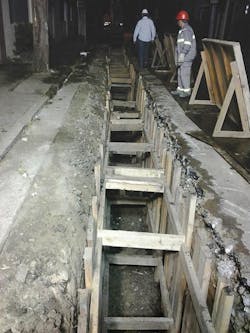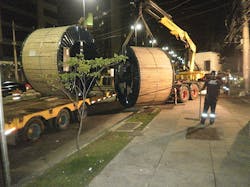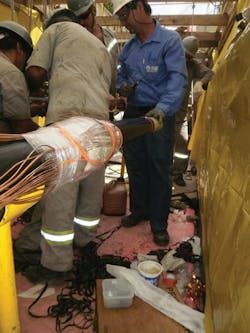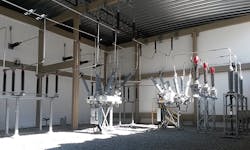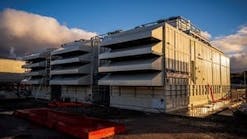AES Eletropaulo Invests in Infrastructure in Brazil
The growing demand and concentration of loads within the fast verticalization of building in the Itaim Bibi and Vila Olimpia areas of São Paulo, Brazil, has created a necessity for reinforcement. AES Eletropaulo, the energy distribution utility, has had to undertake technical and economic feasibility studies to determine the optimum solution.
The solution selected was to install 138-kV underground cables from the 120-MVA, 88/138/13.8-kV ETD Monçöes substation to supply a new 138/13.8-kV ETD Juscelino Kubitschek substation constructed in São Paulo city, one of the main administrative and financial centers of South America. The project also included the installation of additional 13.8-kV distribution circuits.
Engineering Solutions
The 138-kV underground cable circuit consisted of two 138-kV three-phase cables 3.28 km (2 miles) in length, designed initially to operate at 88 kV and with a load-transfer capacity of 110 MVA per circuit. The design of the construction excavation was an open trench, 0.8 m wide by 2.6 m deep (2.6 ft by 8.5 ft). At positions where large interferences would need to be crossed, it was agreed to use horizontal directional drilling (HDD) at a maximum depth of 10 m (33 ft). The 138-kV cables were installed in corrugated ducts filled with bentonite and enveloped with a thermally stabilized backfill.
The two 138-kV three-phase cables, with a conductor cross-sectional area of 1200 sq mm (1.9 sq inches), were cross-linked polyethylene insulated. The design of the system earthing included the cross-bonding of the cable’s metallic sheath between joints at approximately 550-m (1804-ft) intervals.
One innovation introduced in this project to provide improved reliability and take full advantage of the load-transfer capacity of the power cable was the installation of a distributed temperature sensing (DTS) system with software to calculate the real-time thermal rating. The DTS system consists of two multimode fiber-optic pairs, internally inserted under the sheath of the cable. Measuring and data-collection equipment is installed in the Juscelino Kubitschek substation along with software for estimation of the current in real time.
Inovatec Consultants gave technical support to the implementation of the project, and AES awarded contracts to the following manufacturers and contractors:
• Phelps Dodge International Corp. supplied the 138-kV cables and accessories.
• Empreiteira Paulistana was appointed as the civil works contractor.
• EDS Engenharia developed the detailed design.
• Lima Empreendimentos performed the installation and jointing of the 138-kV cables.
Excavation Challenges
Different types of soil were encountered along the cable route from the ETD Monçöes substation to the new ETD Juscelino Kubitschek substation. The most predominant type of soil was classified as alluvial and organic. This soil is a dark turf and highly compressible, unstable and difficult to handle; it has a characteristic smell. The water table level for the majority of the route was at 1.5 m (4.9 ft) and, therefore, above the trench bottom, which was situated at a depth of 2.6 m (8.5 ft).
These terrain characteristics, combined with the various interferences of other utilities installed along the route, complicated the excavation and construction of the duct banks because of the instability of the trench walls and presence of water in a large section of the cable route. Given these demanding conditions, the solution adopted was to open the trenches with a mini-excavator and continuously shore up the trench along the excavations. Because of the low soil cohesion capacity, productivity during the work was impaired.
The work was completed with open trenches used for more than 95% of the length. In some places, because of the large number of obstacles, the excavations initially planned to be mechanized were done manually. This work occurred mainly when the route was in close proximity to existing underground cables and the gas ducts in close proximity to the two terminal high-voltage/medium voltage (HV/MV) substations.
The excavated route tried to follow the design profile and depth of the designed trenches, but because of the probability of interference with the existing facilities of other public service utilities, it was necessary to use duct banks with several horizontal and vertical curves. This resulted in a larger number of lubricating passage boxes to minimize the force required to pull in the cables.
Horizontal Directional Drilling
In addition to the open trench, it was necessary in certain sections of the route to use HDD, which is a nondisruptive method. However, because of the need for cable ducts with a 200-mm (8-inch) nominal external diameter, large drilling machines had to be used.
One innovation used in this construction was the foundation of external terminals where precast concrete bases were used instead of traditional foundations, thereby reducing the number of work hours and project lead time. Similarly, precast concrete structures for the link boxes of the cross-bonding system were used for the first time.
Construction Innovation
Several factors led to innovative engineering and management solutions being required during construction. For instance, the low local-soil reuse rate for backfill created difficulties. Construction of the trenches was allowed during the overnight hours. However, the approved disposal sites for the excavated soil were closed. In addition, truck traffic restrictions during the day prevented the transport of backfill material to the local site for the final disposal of waste. As a result, additional transport costs were incurred for transferring the soil from a temporary site to the approved site during the day.
Because the excavated soil was not suitable for backfill and because construction took place during the rainy season, the conventional deposits of backfill material were unavailable. Hence, the solution was to use recycled concrete that has a high compression rate and reasonable water resistance. This reduced potential settlement of the cable excavation during the rainy season.
The approved nighttime construction had to comply with the current noise-emission legislation, the law of silence, in São Paulo. Nearby residents were reassured of the importance of the project through various forms of communication, which minimized the number of complaints.
One of the major problems of installing underground cables in São Paulo is the dense and disorderly occupation of the subsoil, as there is no specific legislation on this practice. As a result, some companies build their networks without legal authorization, which means existing records of facilities are unreliable. Therefore, it was necessary for AES to undertake pre-site surveys during the design and construction stages using different methodologies: grounding penetrating radar, visual inspection, electromagnetic inspection and, at some positions, pre-excavation.
Despite all the unforeseen problems during construction, this project was completed on time and within the capital expenditure margins.
Project Management
The RSE Juscelino Kubitschek project presented great challenges to the professional management team responsible for all stages of the project. Feasibility studies, budgetary considerations, procurement of licenses and so forth required experienced professionals. They faced adverse environmental situations, a limited construction period, and the need to monitor and control expenditures. The project management methodology adopted was based on the precepts of the “Project Management Body of Knowledge,” the reference guide from the Project Management Institute.
The first step in the management process was to define the key factors required for success by considering all the variables. The project team chose four key factors: safety, quality, time and budget. Based on these drivers, tools and methodologies were defined to manage the progress of the project to ensure success.
Risk Management
To manage risks, the team created a spreadsheet with the probability of each risk that could occur and the impact on the RSE Juscelino Kubitschek project. The team identified there was a risk the project could be suspended because of possible lawsuits by residents and businesses in the region, motivated by the inconveniences created by construction work.
The project team opted to develop a communication plan for the neighborhoods near the underground cable route to provide information on the benefits and the measures taken to minimize any inconvenience. This involved meeting with the community leaders (for example, neighborhood associations and trade associations), delivering flyers to the residents and businesses in the region, and training of employees in the utility relationship centers who were disseminating the information.
Time Management
The Juscelino Kubitschek complex consisted of 138-kV underground cables, construction of a new 138/13.8-kV substation with an installed capacity of 120 MVA, a substation for the overhead-line-to-underground-cable transition and 12 13.8-kV distribution circuits. The completion date was set by governmental agencies, as they planned on the new complex supplying the FIFA World Cup in 2014. This effectively reduced and limited the project time line.
To meet this challenge, the project team established a general chronogram for the Juscelino Kubitschek complex. The chronogram, a form of critical path analysis, established a week-by-week program of the construction works, monitored weekly by the project team. This time management chronogram resulted in the project being completed on May 30, 2014, one month ahead of schedule.
Budget Management
To manage and control the project budget, all disbursements made were allocated to specific cost centers according to the type of payment (materials, services and taxes). The result of this budgetary control mechanism was completion of the project at just 2% more than the original estimate.
Safety Aspects
To ensure both the safety of the public and employees involved in the RSE Juscelino Kubitschek project, measures were adopted and included in the technical specifications in accordance with AES’s basic safety guidelines. Measures were adopted that identified the work sites and traffic diversions during all the activities on public roads.
Special attention was given to shoring up the excavations continuously for ducts, trenches and joint boxes to minimize the risk of landslide as a result of the low-quality soil in the area and depth of the excavation trench. All the construction works were completed without any accidents to members of the public or employees.
A Successful End
The RSE Juscelino Kubitschek underground cable project was successful as it was delivered on time and on budget, despite the short time line and limited financial resources. The determining factor for this success was the project management methodology, strict observation and monitoring of safety and environmental aspects as well as the commitment of the entire project team. Furthermore, other major factors included the prompt solution of all unforeseen problems encountered during the project.
It would be highly desirable if all Brazilian municipalities were to adopt standard disciplines regarding the installation and recording of the position of their underground assets. This would ease the problems encountered by utilities on future projects involving underground construction works, which are expected to increase exponentially in the near future in Brazil.
Roberto Silva Vieira holds a degree in electrical engineering from the Faculdade de Engenharia de São Paulo and an executive MBA degree from Escola Superior de Propaganda e Marketing. He has worked for 20 years in the electricity sector and participated in several major transmission and distribution projects. Vieira is the project manager at AES Eletropaulo responsible for substations and power transmission line projects and constructions in São Paulo, Brazil.
Julio Cesar Ramos Lopes holds a degree in electrical engineering from the Polytechnic School of the University of São Paulo and an international executive MBA degree from the Fundação Instituto de Administração of the University of São Paulo. Lopes held management positions for more than 25 years at AES Eletropaulo in engineering, system planning, design and construction of high-voltage and extra-high-voltage substations and transmission lines (88 kV, 138 kV and 354 kV). He served as chairman of the CIGRE Study Committee B1-Insulated Cables of the Brazilian National Committee of CIGRE from 2008 to 2014. Lopes is currently a director of Inovatec Consultants and a member of IEEE.
